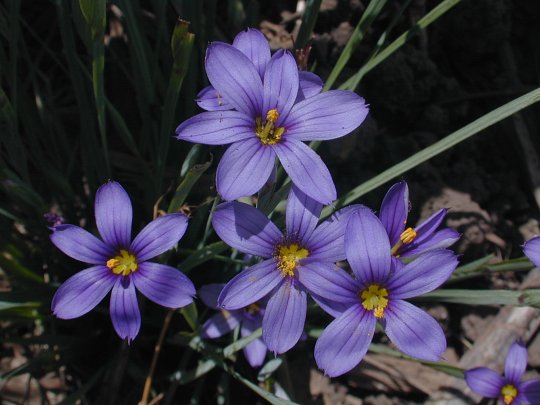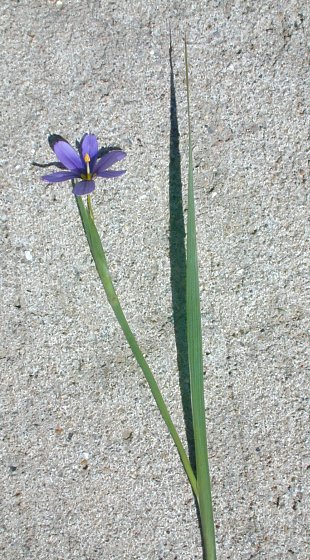Description: This herbaceous perennial plant is about ½–1' tall. It has a loose tuft of basal leaves that emerge directly from the ground. They are green in the shade and often bluish or greyish green in the sun. These basal leaves are linear with parallel venation and up to 1/6" (4 mm.) across; they resemble short narrow Iris leaves. Among the leaves, there develops occasional flowering stalks with umbels of blue-violet flowers. These flowering stalks are usually more narrow than the leaves, but they are same height or slightly taller. Each stalk terminates in a long leaf-like bract, from which a spathe with a pair of short bracts will develop. This spathe may be sessile, or it may develop from a long secondary stalk (a peduncle).

An umbel of
flowers develops between the bracts of the spathe. Usually, only a few
flowers in an umbel will be in bloom at the same time. Each flower is
up to ½" (6 mm.) across; it consists of 3 petals and 3 sepals that
appear
nearly identical to each other. Each petal or sepal terminates in a
tiny pointed tip that is often slightly notched on either side. There
are fine lines of dark violet that lead to the center of the flower –
these function as nectar guides. The base of each flower is bright
yellow, from which there develops the sexual organs in the form of a
bright yellow spike. At the base of each flower, there is a slender
pedicel up to 1" long. There is no noticeable floral scent. The
blooming period occurs during late spring or early summer, and lasts
about a month. The globoid 3-celled seed capsules split into 3
sections, releasing small black seeds; these can be carried a short
distance by gusts of wind. The root system is coarsely fibrous, and can
form new offshoots.
Cultivation:
The preference is full or partial sun and moist to average conditions.
Growth is best in a rich loam that is high in organic material. Light
shade is also tolerated, but flowers will be fewer in number. The
plants are fairly easy to grow under these conditions, and will
gradually form larger clumps. Foliar disease doesn't appear to bother
this and other species of blue-eyed grass.
Range & Habitat:
Stout Blue-Eyed Grass is widely distributed in Illinois, but it is less
common or absent in many NW counties (see Distribution
Map). This wildflower is native to Illinois. This plant can
be found occasionally in moist to
mesic black soil prairies, but it is more common in habitats with woody
vegetation. These habitats include floodplain forests, thickets,
woodland borders and openings, moist oak savannas, and the slopes of
rivers. This plant usually occurs in grassy areas, as broad-leaved
forbs tend to crowd it out.
Faunal Associations:
Halictid bees, including green metallic bees, are probably the most
important visitors of the flowers,
where they collect pollen or suck nectar. Bumblebees, other kinds of
bees, and bee flies are less frequent visitors seeking nectar, while
Syrphid flies feed on pollen or suck nectar. The seeds and other parts
of this plant are eaten to a limited extent by the Greater Prairie
Chicken and Wild Turkey.
Photographic Location:
The photographs were taken at (or near) the webmaster's wildflower
garden in Urbana, Illinois.
Comments:
This is a pretty plant while in bloom, and it has neat foliage.
Distinguishing different species of Blue-Eyed grass can be rather
difficult. Stout Blue-Eyed Grass has leaves that are slightly broader
than most species of Blue-Eyed Grass, and it occasionally produces
flowers from long secondary stalks, as shown in the lower photograph.
The flowers are consistently deep blue-violet, rather than pale blue or
white. Only a single spathe with an umbel of flowers is produced from a
flowering stalk, while Sisyrinchium albidum (White
Blue-Eyed Grass) produces two spathes. If you find a Blue-Eyed Grass
with blue-violet flowers in a wooded area, this is the species that you
are probably looking at. Other Sisyrinchium spp. in
Illinois prefer sunnier habitats in either prairies or moist sandy
meadows.